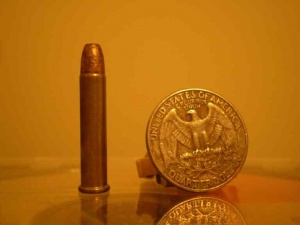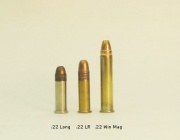.22 Winchester Magnum Rimfire
| .22 Winchester Magnum Rimfire | ||||||||||||||||
|---|---|---|---|---|---|---|---|---|---|---|---|---|---|---|---|---|

| ||||||||||||||||
| .22 Winchester Magnum Rimfire | ||||||||||||||||
| Type | rimfire | |||||||||||||||
| Country of Origin | USA | |||||||||||||||
| Specifications | ||||||||||||||||
| Parent Case | .22 WRF | |||||||||||||||
| Bullet Ø | .224 in (5.7 mm) | |||||||||||||||
| Neck Ø | .240 in (6.1 mm) | |||||||||||||||
| Base Ø | .241 in (6.1 mm) | |||||||||||||||
| Rim Ø | .291 in (7.4 mm) | |||||||||||||||
| Rim Thickness | .046 in (1.2 mm) | |||||||||||||||
| Case Length | 1.052 in (26.7 mm) | |||||||||||||||
| Full Length | 1.35 in (34 mm) | |||||||||||||||
| Primer | Rimfire | |||||||||||||||
| Production & Service | ||||||||||||||||
| Designer | Winchester | |||||||||||||||
| Design Date | 1959 | |||||||||||||||
| Manufacturer | Winchester | |||||||||||||||
| Production Dates | 1960-Present | |||||||||||||||
| Ballistic Performance Sampling | ||||||||||||||||
| ||||||||||||||||
The .22 Winchester Magnum Rimfire, more commonly called .22 WMR, .22 Magnum, or simply .22 Mag, is a rimfire rifle cartridge. Commonly loaded with a 40 grain (2.6 g) bullet, it can deliver velocities in the 2,000 ft/s (610 m/s) range from a rifle barrel. It is also available with 30-grain (1.9 g) loads (2 g) and can achieve speeds of 2,300 ft/s (700 m/s).
Contents[hide] |
[edit] History
The .22 WMR was introduced in 1959 by Winchester, but was not used by Winchester until the introduction of the Model 61 slide rifle well into 1960.[2] By that time, Smith and Wesson and Ruger had revolvers for it, and Savage had come out with the Model 24, a .22/.410 combination rifle. It was the only successful rimfire cartridge introduced in the 20th Century.The .22 WMR uses a larger case than the more popular .22 Long Rifle, both in diameter and length. The .22 WMR's case is thicker, allowing higher pressures. The combination of more powder and higher pressures gives velocities over 2,000 feet per second (610 m/s) from a rifle using a 30-grain (1.9 g) bullet, and 1,500 feet (460 m) per second (460 m/s) from a handgun.
[edit] Uses
Since the .22 WMR generally uses the same weight bullets as the .22 Long Rifle, it is generally used in similar situations. The 40-grain (2.6 g) .22 WMR at 100 yards still retains the velocity of a .22 LR at the muzzle, which can provide improved penetration at all ranges, and more reliable expansion at longer ranges with expanding bullets.
If sighted in for maximum point blank range on a 3-inch (76 mm) high target, the 40-grain (2.6 g) .22 WMR can reach ranges of nearly 125 yards. This makes the .22 WMR an effective short to medium range varmint rifle cartridge. The relatively quiet sound of firing and negligible recoil also make it a very pleasant round to shoot for extensive periods of time. It is less expensive to shoot than its nearest competitors, the centerfire .22 Hornet, the .17 HMR, and the new 5.7 x 28 mm.
[edit] Firearms using .22 WMR
The .22 WMR operates at pressures beyond what normal blowback actions typically handle. It first appeared in the Savage Model 24 combination rifle, followed by Winchester's own Model 62. A number of single-shots and repeaters were offered in .22WRM, and the self-loading Jefferson Model 159.[3] In the 1990s semi-automatic .22 WMR rifles were introduced by Sturm, Ruger, Savage, and Marlin. Also recently introduced is the new 597 model from Remington. Before this time, most .22 WMR firearms were bolt action rifles, though the .22 WMR is also found in a number of revolvers by Taurus, North American Arms, Tanfoglio, and Sturm, Ruger, and was previously available in semi-automatic pistols by the now defunct manufacturers Grendel and AMT (since resurrected by High Standard). Both of these designs used specially designed chambers with flutes or gas ports, designed to lubricate the long, thin cartridge with gasses from the chamber, overcoming the Blish effect and allowing easy extraction of the cartridge.[4]
[edit] Ammunition

The .22WMR is little more than an enlarged, more powerful version of the much earlier .22 WRF[5] (which can also be fired in any weapon chambered for .22WMR).[6] It was for a time the most powerful rimfire round available,[7] and even outperformed the .22 WCF.[8]
While more powerful than the .22 Long Rifle, ammunition is not available in as large a variety as .22 LR. Availability is also not as great, either; while the .22 WMR is by no means hard to find, nearly every retailer that sells ammunition will carry .22 LR. The price of .22 WMR is substantially higher than almost all .22 LR, though it is less expensive than the new .17 Rimfire calibers. Since many of the rifles that chamber the .22 WMR use tubular magazines, bullet noses are generally flat or blunt to allow smooth feeding. Recently, new bullets have emerged from Remington, CCI, and Hornady and have 30 or33-grain (2.1 g) poly-tipped ballistic tips.[9][10][11]While a pointed bullet is not going to rest against the primer of the round in front of it (like in a centerfire cartridge), a pointed bullet could still hang on the manufacturer's stamp, which is found in the middle of the base of the cartridge.Due to the limited selection of commercial ammunition, the .22 WMR was the case used by a small but dedicated group of wildcatters for handloading high performance rimfire ammunition. Generally these loads would use more aerodynamic pointed bullets, the same type used by .22 caliber centerfire cartridges. While often heavier than standard .22 WMR bullets, the sharp nose and tapered tail retained velocity better, and delivered more energy downrange. Other wildcatters would neck the .22 WMR down to smaller calibers, such as .20 (5 mm) and .17 (4.5 mm) or even smaller, in an attempt to get maximum velocity and the flattest possible trajectory.
[edit] Applications
The .22 WMR is effective out to 125 yd (115 m) and capable of handling varmints such as coyotes or wolves, but too destructive for small game, such as rabbits or prairie dogs or anything intended for eating.[12]
[edit] See also
[edit] References
- ↑ Cartridges of the World 11th Edition, Book by Frank C. Barnes, Edited by Stan Skinner, Gun Digest Books, 2006, ISBN 0-89689-297-2 pp. 490, 492
- ↑ Barnes 1972, p.275, ".22 Winchester Magnum Rimfire".
- ↑ Barnes 1972, p.275, ".22 Winchester Magnum Rimfire".
- ↑ AMT AutoMag
- ↑ Barnes 1972, p.275, ".22 Winchester Magnum Rimfire".
- ↑ Barnes 1972, p.275, ".22 Winchester Rimfire (WRF)".
- ↑ Barnes, p.275, ".22 Winchester Magnum Rimfire".
- ↑ Barnes 1972, p.275, ".22 Winchester Magnum Rimfire".
- ↑ Remington Magnum Rimfire: 22 Win Mag PR22M1 33-grain AccuTip-V™ Remington Arms Company, Inc.
- ↑ CCI: Varmint 0073 22 Magnum RF V-MAX 30-grain poly-tip publisher=CCI
- ↑ Hornady: 22 WMR 30-grain V-MAX Hornady Manufacturing, Inc.
- ↑ Barnes 1972, p.275, ".22 Winchester Magnum Rimfire".
- Barnes, Frank C., ed. by John T. Amber. ".22 Winchester Magnum Rimfire", in Cartridges of the World, pp.275. Northfield, IL: DBI Books, 1972. ISBN 0-695-80326-3.
- Cartridges of the World 11th Edition, Book by Frank C. Barnes, Edited by Stan Skinner, Gun Digest Books, 2006, ISBN 0-89689-297-2 p. 479
[edit] External links
- Chuck Hawks' page on the .22 WMR
- Chuck Hawks on .22 WMR ammunition selection
- The .22 WMR TODAY, Guns Magazine, June, 2001 by C. Rodney James
- Three .22 WMR Loads From Remington, Handguns Magazine, by Phil W. Johnston
- Reloading Techniques: .22 Win. Magnum Rimfire, Performance Shooter, April 1996

